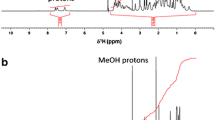Abstract
The aim of the study was to develop an LC method for honeybee venom analysis, using cytochrome c as an internal standard. The SynChropack C8 6.5 μm, 4.6 × 100 mm column was applied. The bee venom was separated by linear gradient 5–80% B at 30 min (eluent A—0.1% TFA in water, eluent B—0.1% TFA in acetonitrile:water (80:20)). The flow rate of mobile phase was maintained at 1 mL min−1, injection volume: 40 μL, separation temperature: 25 °C. The analysis was monitored at 220 nm. Several honeybee venom constituents were separated and the content of four of them (apamine, mast cell degranulating peptide, phospholipase A2 and melittin) were determined. By applying this methodology differences in chemical composition of honeybee venom were evaluated. In order to confirm the data obtained, the following steps and parameters were taken into account for the validation of the method: selectivity, precision (injection repeatability, analysis repeatability), accuracy (recovery), linearity and operating range, limit of detection and limit of quantitation. All steps of validation proved that the developed analytical procedure was suitable for its intended purpose (standardization). Due to its simplicity, the developed method can be easily automated and incorporated into routine operations both in the bee venom identification, quality control and assay tests.

Similar content being viewed by others
References
Dong JS, Jae WL, Young HL, Ho SS, Chong KL, Jin TH (2007) Pharmacol Ther 115:246–270. doi:10.1016/j.pharmthera.2007.04.004
Park HJ, Lee SH, Son DJ, Oh KW, Kim KH, Song HS (2004) Arthritis Rheum 50(11):3504–3515. doi:10.1002/art.20626
Kwon YB, Ham TW, Kim HW, Roh DH, Yoon SY, Han H (2005) J Pharmacol Biochem Behav 80(1):181–187. doi:10.1016/j.pbb.2004.10.017
Kim HW, Kwon YB, Ham TB, Roh DH, Yoon SY, Lee HJ (2003) J Vet Med Sci 65(3):349–355. doi:10.1292/jvms.65.349
Putz T, Ramoner R, Gander H, Rahm A, Bartsch G, Thurnher M (2006) Cancer Immunol Immunother 55(11):1374–1383. doi:10.1007/s00262-006-0143-9
Russell PJ, Hewish D, Carter T, Sterling-Levis K, Ow K, Hattarki M (2004) Cancer Immunol Immunother 53(5):411–421. doi:10.1007/s00262-003-0457-9
Szokan G, Harvath J, Almas M, Saftics G, Palocz A (1994) J Liq Chromatogr 17(16):3333–3349. doi:10.1080/10826079408013516
Rader K, Wildfeuer A, Wintersberger F, Bossinger P, Mucke HW (1987) J Chromatogr 408:341–348. doi:10.1016/S0021-9673(01)81820-3
Gauldie J, Hanson JM, Rumjanek FD, Shipolini RA, Vernon CA (1976) Eur J Biochem 61:369–376. doi:10.1111/j.1432-1033.1976.tb10030.x
Banks BEC, Dempsey CE, Pearce FL, Vernon CA, Wholley TE (1981) Anal Biochem 116:48–52. doi:10.1016/0003-2697(81)90320-1
Packova V, Stulik K, Hau PT, Jelinek J, Vins I, Sykora D (1995) J Chromatogr A 700:187–193. doi:10.1016/0021-9673(94)01170-J
Pattanaargson S, Roboz J (1996) Toxicon 34(10):1107–1117. doi:10.1016/0041-0101(96)00083-9
Packova V, Stulik K (2000) J AOAC Int 83(3):549–554
Peiren N, Vanrobaeys F, de Graaf DC, Devreese B, Van Beeumen J, Jacobs FJ (2008) Toxicon 52:72–83. doi:10.1016/j.toxicon.2008.05.003
Peiren N, de Graaf DC, Vanrobaeys F, Danneels EL, Devreese B, Van Beeumen J, Jacobs FJ (2005) Biochim Biophys Acta 1752:1–5
Taverniers I, De Loose M, Van Bockstaele E (2004) Trends Analyt Chem 23:535–552. doi:10.1016/j.trac.2004.04.001
ICH Harmonized Tripartite Guideline (1996) Validation of analytical procedures: methodology, ICH Topic Q2B (CPMP/ICH/281/95). The European Agency for the Evaluation of Medicinal Products
Acknowledgments
This work was supported by grant no. 1807/B/P01/2008/35 from the Polish State Committee of Scientific Research.
Author information
Authors and Affiliations
Corresponding author
Rights and permissions
About this article
Cite this article
Kokot, Z.J., Matysiak, J. Simultaneous Determination of Major Constituents of Honeybee Venom by LC-DAD. Chroma 69, 1401–1405 (2009). https://doi.org/10.1365/s10337-009-1052-9
Received:
Revised:
Accepted:
Published:
Issue Date:
DOI: https://doi.org/10.1365/s10337-009-1052-9




